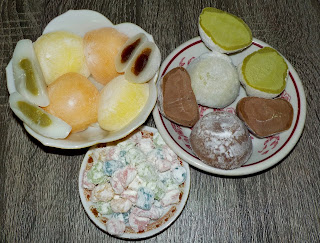Let’s play one of those “name this” games. Name a dessert made with rice. Bet your answer would immediately be “rice pudding”. Most folks would also consider this dessert’s origin to be either the United Kingdom, or America itself. That would make you lose points in my game, as we will be going back to Asian culture instead. Actually, way back to the Western Zhou Dynasty, of 1047 BCE, China. This country is known to be the first cultivator of rice, and rice pudding is called “eight treasure”, or” eight jeweled”, rice porridge.
Sweet rice, aka sticky rice, is more glutinous than your average, every day white rice. It can be compacted more tightly around a sweet or savory filling, and served as appetizers, side dishes or desserts. A one cup serving contains 37 grams of carbs which is about 2 and ½ servings; very little protein and fiber. So why is it eaten, on a daily basis, in many countries, not just Asian cultures? Sticky rice has antioxidant properties that help lower oxidative stress, and is rich in minerals like zinc, magnesium, copper, phosphorus and selenium. Health benefits include increased bone density, decreased inflammation, and improved heart health. The con side of all this is, what the rice is eaten with of course. If you make a large batch of deep-fried rice balls that contain a mixture of chocolate and caramel, then eat the entire batch. Oh boy, are you going to get yourself seriously sick, and just might end up in the hospital. In other words, no matter how healthy something is, still have to keep in mind that annoying little word, moderation.
Is all sweet rice the same, no matter what country it is grown in? Surprisingly not. Here in Monticello, we have Ja-roen Thai Restaurant (thankfully still open, and everyone wishes the sushi would be brought back…but I digress). In Moab, there are several Thai restaurants that are of high quality as well. One dessert that is typically on menus is Mango with Coconut Sticky Rice (Khao Niao Mamuang). The rice used is whiter, less opaque and longer than that used in Japanese restaurants. After the rice is prepared, it is combined with full-fat, sweetened coconut milk, and left to rest to soak up the milk.
So, it is no surprise that Roy and I are super fans of Asian cuisines, and he benefits from all my attempts at creating many of our favorite dishes. Lately, I have been on a mochi kick. Say what? Mochi which is made from a Japanese grown short grain, opaque form of sweet rice. The traditional method of making the mochi paste is to steam the rice, then pound it out inside a wooden bowl with a wooden mallet. The paste is then formed into balls that can be eaten as is, or the paste is formed around sweet or savory fillings. Nowadays, the flour can be purchased, water and sweetener added, and the paste simply stirred up in a bowl. For those truly interested, you can learn, in six easy steps, to make your own homemade mochi, with your purchased flour, at: https://www.instructables.com/How-to-Make-Homemade-Mochi/
Purchasing premade mochi, online, is available, shipped in from Japan, and most vendors have reasonable prices. The products may have a filling, or you can purchase just the simple mochi balls that resemble mini-marshmallows covered in powdered sugar. But wait, if you happen to be in Monticelli, stop in at Blue Mountain Foods, go to the ice cream section and you can purchase “My Mochi”; mochi wrapped around frozen balls of rich and delicious ice cream (my favorite flavors are green tea and double chocolate). Remember though, these little goodies are high in carbs, so one is a perfect serving. Roy and I, though, had a fun time taste testing all the products we could find; in moderation of course (wink, wink).
What does mochi taste like? Similar to a marshmallow, but not as sweet, and the texture is similar, but gooier. Oh dear, now another warning that sort of ruins some of the fun of eating mochi. Do not put an entire mochi in the mouth and attempt to eat it whole. Mochi must be eaten in small bites and thoroughly chewed before swallowing. Due to its glutinous makeup and dense, thick, sticky texture, it can cause a choking hazard. If not chewed, but simply swallowed, the sticky mochi gets stuck in the throat, and can lead to suffocation.
Please do not be turned off by this warning, since common sense dictates that anything eaten must be in manageable bites anyway, but can still cause a choking hazard.
Roy and I dream about traveling to the various Asian countries someday, but until then, we can enjoy the cuisines, either in a restaurant, or making it at home. Try it, you just might surprise yourself, and truly like it!
Mary Cokenour



No comments:
Post a Comment